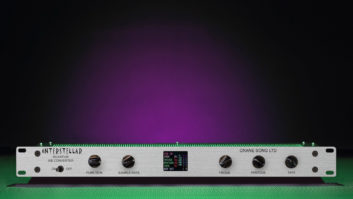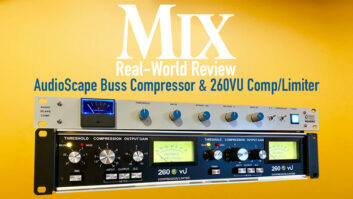The Crane Song Trakker is a single-channel, all-Class-A analog compressor-limiter that uses all discrete components in the signal path. Housed in a single-rackspace steel-and-aluminum chassis, the unit has transformerless input and outputs and operates on AC mains voltages from 100 to 240. The Trakker uses Pulse Width Modulation to derive a control signal for the gain changing element-in this case, a Field-Effect Transistor or FET.
Digital control through PWM is not new, and neither is the use of gain-changing FETs: The ’60s vintage EMT 156 Stereo Compressor/Limiter is an example of a PWM-controlled processor and the revered UREI 1176LN is a good example of an FET-based peak limiter. The technique of converting an analog waveform into a digital pulse train (A/D conversion) for use as a control voltage has two distinct advantages: Once digital, the control signal can be easily manipulated, and in ways not always possible with analog circuitry. Second, the quality of the analog signal path remains pristine from input to output. In the case of the Crane Song Trakker, a pair of parallel FETs, responding to the PWM sidechain control signal, control the audio output by shunting the output audio to ground. This is the same way a resistive passive volume control works-the most neutral-sounding gain reduction circuit available.
PWM CONTROLTrakker designer Dave Hill has studied the properties of various newer and vintage compressors and has developed a set of PWM algorithms that emulate four different basic compressor types: Hard Knee, Soft Knee, Optical and Air-Optical. In addition to the four compressor types, there are four amplifier/modulation styles available that further modulate the compressor’s action: Clean, Vintage, Clean VCA and Vintage VCA. These tone coloration circuits add further processing to the PWM control signal and are selected by a 16-position rotary Character switch, divided into four quadrants. Each quadrant is further subdivided into the four amplifier/styles and selections are indicated by a different colored LED. Winding through sixteen positions on the Character switch reveals a relay that creates a slight delay between settings (.2 ms). Once you have decided which compressor type and amplifier/style you would like to use, the unit behaves and works like any another compressor that includes adjustable Attack, Release, Threshold and Knee (Slope or Ratio) controls. The big feature here is that if you change your mind or if a change in the music no longer fits the compressor/amp style you’ve chosen, you don’t have to find and repatch in a different compressor, you just select another compressor type/amplifier style with the Character switch.
COMPRESSOR TYPESThe Hard Knee setting can be thought of as a limiter. When using this mode I had to re-adjust the Knee control (ratio) as well as both the Attack and Release controls. If you like to squash and spank audio, this is the best and most controllable device for it that I have seen. I found all the grit and graininess I could ever need, without having to worry about quality of the audio path suffering. Soft Knee offers a kinder, gentler sound, much like the OverEasy mode in a dbx 160SL. I found that Soft Knee worked better as a music program processor than it did on most individual instrument tracks. With the Optical mode you’ll get a more program-dependent action: The release time increases the longer the signal is present. Air-Optical is the same as Optical except for a high-frequency boost; this emulates the way some vintage tube compressors “build in” a high-frequency tilt to maintain an overall flat response (one of the reasons certain vintage gear sounds so wonderful as soon as you patch it in). Switching between Optical and Air-Optical didn’t require any re-adjustment, and the sound is a tinge more open in Air-Optical. I used Air-Optical for vocals and Optical for bass guitar and synths.
AMPLIFIER/STYLESThe Amplifier/Style types start with Clean or Transparent, the cleanest mode of the Trakker. This takes full advantage of the discrete Class A audio path. Vintage has the sound of an old triode tube circuit or old-style solid-state Class A-coloration is mostly secondharmonic, with the third harmonic coming in the closer to clip you run the unit. With some vintage tube and solid-state compressors, during gain changing, there is some feed-through of the control voltage that introduces modulating artifacts to the finished sound. These artifacts are mostly heard when fast attack and release settings are used. This is called VCA on the Trakker, and it can be added to either the Clean or the Vintage styles (hence the names Vintage VCA and Clean VCA). The VCA setting introduces dynamic harmonic content change or transit harmonic distortion; the sound becomes thicker while the gain is changing. This is done to keep the audio path of the highest quality. The amplifier styles are easiest to hear in Hard Knee mode, as these qualities come out more when a compressor is working hard. I found the Vintage style very good for vocals and guitars. The Clean style was better for bass and program material, and VCA seems better for drums and percussion.
USING THE TRAKKERUsing the Trakker is the same as any other compressor, except that here, all the controls interact more. There is an Attack control that ranges from zero, the fastest, to ten for the slowest. The same number scale is used for the Release control. Since there are four compressor types available, there are no time calibration marks silk-screened on the front panel. (It would require four sets of marks on the front panel, one set for each compressor type.) Plus, both the attack and release times depend on the Knee control setting, the Threshold setting and the program material. The Knee control is similar to a ratio control except it really changes the shape of the input/output graph. Furthermore, changes in attack and release times alter the shape of the ratio slope. The Knee control ranges from the most gentle slope, at zero, to ten for the steepest or most aggressive. “Aggressive” is the word here-I was able to get tremendously hard compression sounds when using Hard Knee and higher Knee control settings. Like these controls, the Threshold control ranges from off for no compression to ten for maximum compression. Also, as with all the controls, Threshold must be readjusted even for the same amount of gain reduction if you change compressor types.
Metering is by way of a 22-element LED VU meter with overload indicator. You can switch between Output and Gain Reduction. In GR mode, the meter lights solidly around the average gain reduction amount, with peak reductions flashing higher. Handy! However there is no way to monitor input level. Final output level is controlled by the Gain control, a makeup control that offers 0 to 14 dB of extra gain. This control does not attenuate the output, and there is no mute switch. The hard-wired Bypass switch connects the input to output while the compressor continues to work for setup purposes. The unit defaults to Bypass when off, and up to eight Trakker compressors can be linked for surround mixing.
Arriving at a sound with the Trakker is easy, but it helps if you have a good idea in mind of what kind of sound you want. There are many recommended start-up settings available for the first- time user. The manual suggests a UREI LA-3 leveling amp emulation by using Optical/Clean with Attack set to 4, Release set to 5.5 and the Knee at 6. If you use these settings and go to Optical/Vintage, then the sound would be closer the older tube LA-2 unit. (More settings of other vintage compressors are available at www.cranesong.com.)
I found the Trakker extremely useful for any compressor application with a sound that runs from extremely transparent and neutral to as grungy and colorful as you want. Priced at $1,695, the Trakker provides the engineer with a whole palette of artistic sound choices in a single, versatile unit.
Crane Song, 2117 E. Fifth St., Superior, WI 54880; 715/398-3637; fax 714/398-3279; www.cranesong.com.







